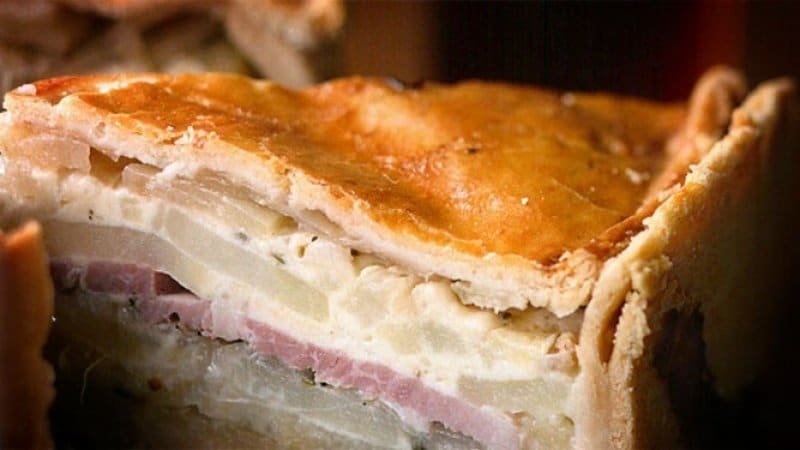
Fidget pie… following in the tradition of so many British dishes with creative names that make you wonder how they came about. Yet this traditional Shropshire favourite was, until recently, not really a favourite at all. Few had heard of it. Luckily for us, it’s surging in popularity again so read on to learn about this delectable combination of ham, apples, potato, and various other local treats.
So What Is It?
The Fidget Pie is bursting with the flavours of fresh Shropshire produce. While there are a number of different recipes out there for Fidget Pie, all share the common ingredients of ham, potatoes, onion, and apple. After that, it seems to be a bit of a free-for-all. I’ve seen recipes with or without cream, mustard, and cider, or any combination thereof. Some recipes call for the ingredients to be layered within the pie shell, while others seem to be ground together into something resembling a pork pie. Still others top the pie with mashed potato, instead of putting potato slices within the pastry shell. This latter version definitely goes against the idea that the pie was a handy lunch for workman, akin to the Cornish Pasty.
But Why Fidget Pie?
So where did its name come from? Prepare for a couple of alternative explanations. Did it come from the fact that the pies were five-sided and therefore easy for farmers to hold? That seems to be one of the most commonly-given reasons but one that I have a hard time accepting. For one thing, I have not seen any version of the pie that is five-sided. And how did five-sided become fidget?

Explanation number two is that the name is based on the local term for a polecat – fitchett. Why? The claim is that the pie smells rather ripe when cooking, like a polecat. Having made the pie, I could detect no discernible animal odour!
So where does the name come from? I don’t know but neither of these suggestions strikes me as particularly convincing.
Making a Fidget Pie
You can find lots of different recipes online but I opted to adapt the one given in Glyn Hughes’ The Food of England cookbook. My finished pie may not have been the most picturesque (I call it rustic), but it was very tasty with a dash of wholegrain mustard on the side.

3 medium potatoes, peeled and finely sliced
2 onions, sliced
2 cooking apples, peeled, cored and sliced
3 slices gammon or ham, cut into strips (You want the slices to be a decent thickness.)
1½ tbs butter
2 tsp brown sugar
Salt and pepper
½ tsp ground nutmeg
5 oz cider (or you could use stock as in the original recipe)
Shortcrust pastry for the base and top of your pie
Milk or beaten egg, to glaze
Preheat the oven to 180 °C / 350 °F / Gas 4. Melt the butter in a frying pan and fry the potatoes, onions, and apples in batches until they turn a light golden colour. Once cooked, remove from the pan and keep warm on a plate.
Lightly fry the ham in the remaining same frying pan.
Line a deep pie dish with pastry. Then layer the ham with the potatoes, apples, and onions, adding salt, pepper, and a dash of nutmeg as you go. Once you have used all the filling, pour in the cider or stock.
Use the remaining pastry to top the pie, making sure to cut a slit for the steam to escape. Brush with milk or a beaten egg.
Bake for 30 minutes, then reduce the oven to 170 °C / 325 °F / Gas 3 for a further 10-15 minutes or until the pie is golden brown.
The pie can be eaten hot or cold.



One thought on “Ever Heard of Fidget Pie?”
Comments are closed.